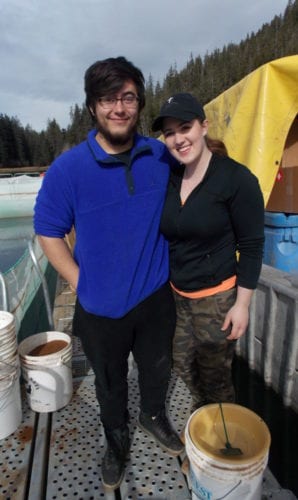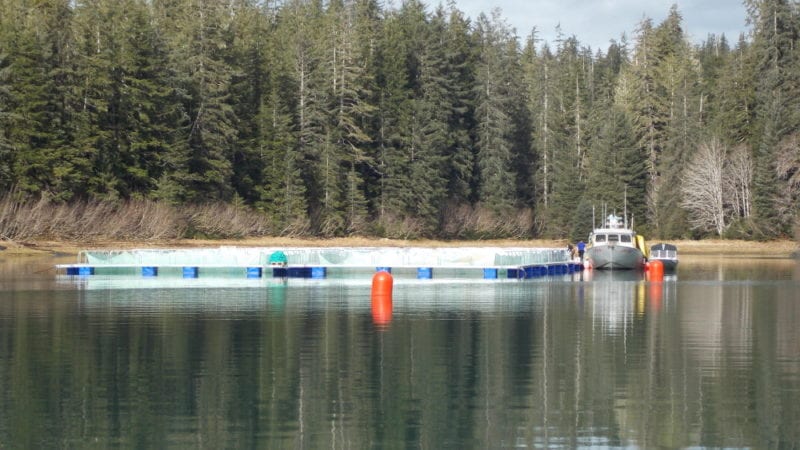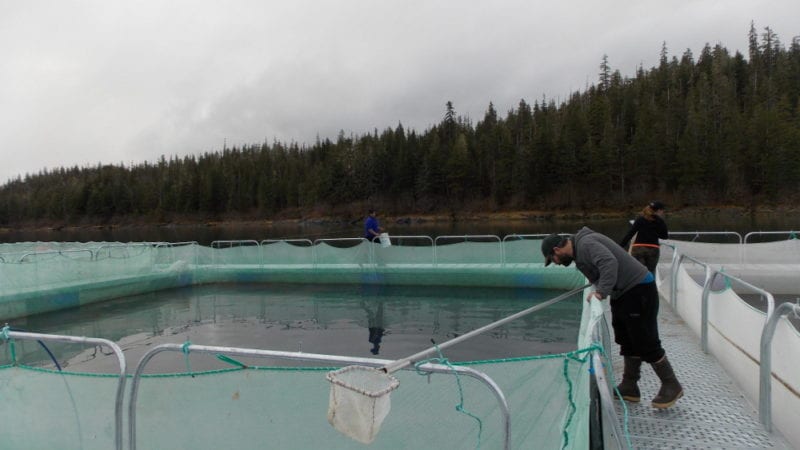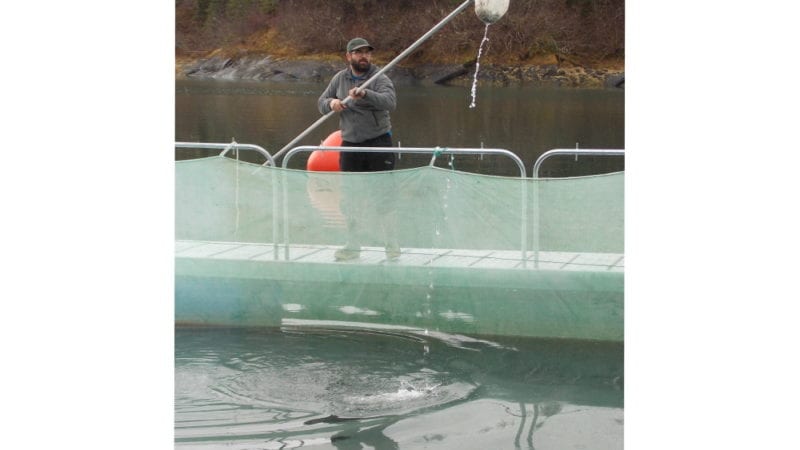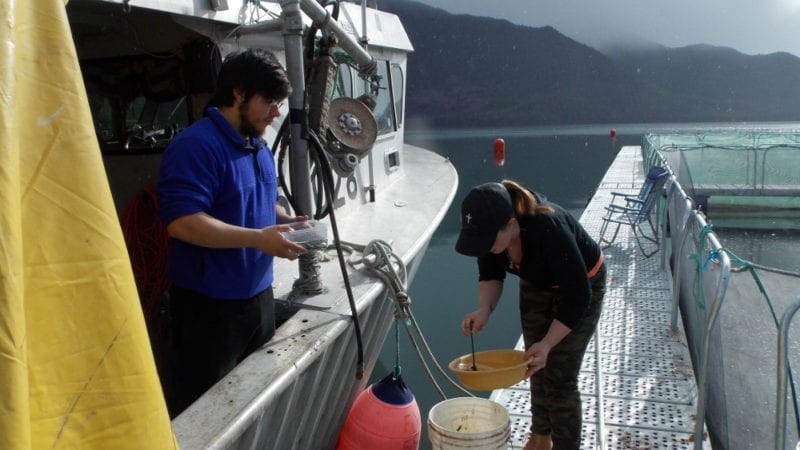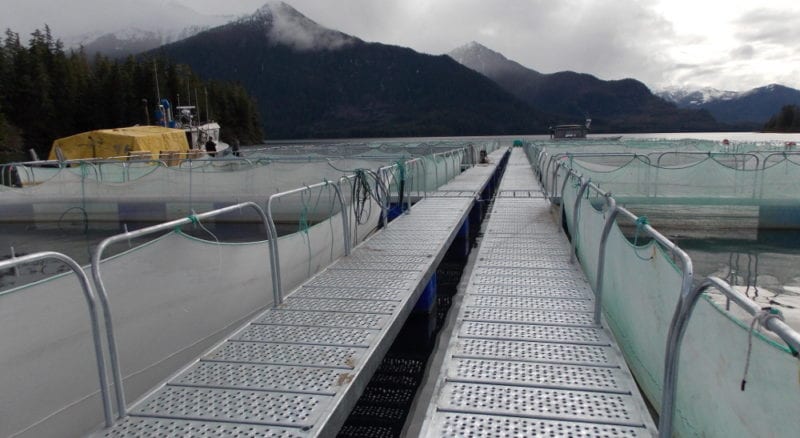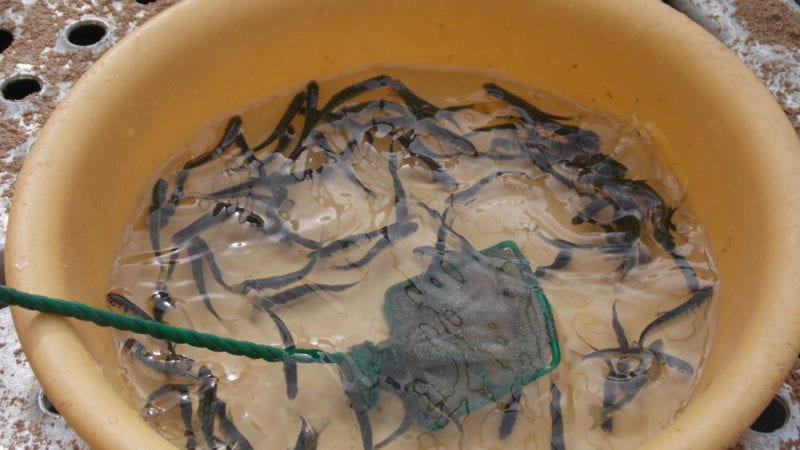Twenty-two million tiny chum salmon are growing in net pens in Thomas Bay near Petersburg this spring. The site is a new release location for hatchery chums produced by the Northern Southeast Regional Aquaculture Association’s Hidden Falls hatchery on Baranof Island. And a young couple from Petersburg is spending the next few months living at the remote site and feeding the hungry fish.
It’s about an hour boat ride across Frederick Sound to the snow-capped bay on the mainland. Inside Thomas Bay, tucked away into a cove on the east side of Ruth Island, are 10 floating net pens, anchored to the sea floor and roped to shore. It’s a day after a big wind blew through and it’s a good thing the pens were well secured.
“Yeah we had like three footers in here but that was probably the worst weather that we’ve had in here so far, it’s pretty tucked in most of the time,” said
Robyn Cardenas.
“We had the front two net pens, those easterly winds billowing about ten feet up in the air and caused quite a panic and running around moving weights trying to get those nets down,” her husband Daniel said. “We didn’t lose any fish but definitely panic. You know woke up stretched my arms looked out the window and the fish are flying, almost seemed like.”
“You never really know what you’re gonna get,” she said. “For a while we were iced in and we had to de-ice the pens every day so that the fish would have access to feed. So it’s definitely nice when we’ve got sunny weather and no ice or waves in here.”
The two grew up in Petersburg and married last year. It’s their first experience raising hatchery fish but they’ve both worked commercial fishing. Now they’re living on Robyn’s father’s fishing boat tied up to the net pens, listening to the radio and going about their daily chores. Most of that daily work is feeding the young fish.
The two walk the floating metal boardwalks and toss scoops of fish food from buckets into the pens. They start feeding the fish at eight in the morning and finish around four. As the chums grow larger they’ll be eating more and the feedings will increase.
“It’s been really exciting,” said Daniel. “We went back to Washington after we got married in Petersburg and heard about this job and dropped everything and a week later we were up here and on a boat and at the pens. It’s really exciting and things are always moving very fast for us.”
“Yeah we couldn’t do it without my dad and my grandpa,” Robyn said. “They offered to let us live on their boats and so that’s been pretty cool. Yeah it was fun to just kinda drop everything and leave because after living in Washington for over a year we were ready to get back home, ready to be back in Alaska.”
The couple is contracting to raise the fish produced by NSRAA. A total of 22 million were moved to the pens in mid-February. The eggs for these fish were collected last July at Hidden Falls. The fish normally would have been released nearer to that facility, but the hatchery non-profit wants to try a new remote release site. The reason for that is Hidden Falls returns have been dismal in recent years, and the hatchery organization suspects that whales and other predators are eating the young fish right after they’re set free. They’re hopeful this and other new release sites will help with that problem.
“Most of our projects we have a trained staff member on site all the time and this project for NSRAA is unique in that we don’t have that onsite presence all the tim,” said Matt Golden, a fish culturist at NSRAA’s Medvejie Hatchery near Sitka who helps with remote chum rearing sites. Golden is visiting for the day to bring out fish food and vaccine, check on the fish and help train the Cardenases. They’re weighing bowlfuls of the young chums to check their size.
Hidden Falls chums have long been an early season opportunity for commercial purse seiners from Petersburg and elsewhere. Commercial fishing organizations estimate the fish to be released this year in Thomas Bay could be worth around three and a half million dollars at the docks and other gear groups are hoping to catch some of the returning chums. The new site was controversial in Petersburg though, with some concerned about the impact on the troll fishery and other marine species in the bay.
Golden explains the net pens were built in Chile and assembled in Thomas Bay when the bay was partially iced over. He was part of the crew that moved the young fish to the new site. “Yeah so I was on the fry transfer boat from Hidden Falls,” Golden said. “So we started that roughly on the 15th of February is when we first started bringing fish over. We brought ‘em over from the Hidden Falls Hatchery, which is on eastern Baranof Island which is roughly 12 hours from here. Our shortest time was 11 hours one way. So we ended up doing that back to back six days in a row and got all the fish here.”
Golden said the fish look like they’ve grown since they were first put into Thomas Bay. Once they grow to the right size, the young salmon will be released in stages, some in May, others in June. The first adult fish are expected back three to four years later, in 2020-21. The net pens will stay in place year round on the east side of Ruth Island.
Robin and Daniel Cardenas will be there too for the next few months, feeding the fish and starting their new life together.

